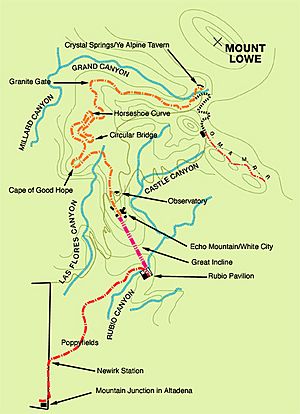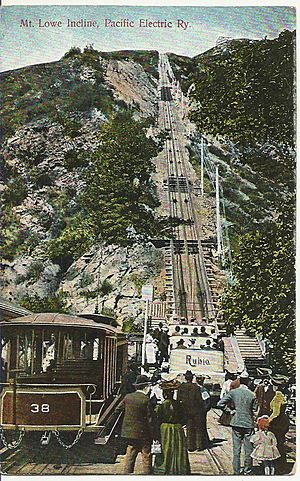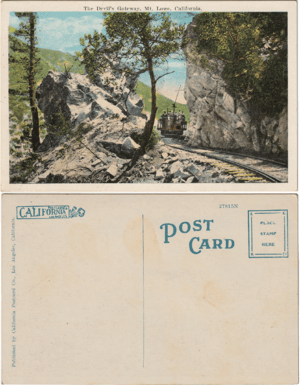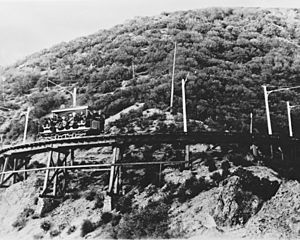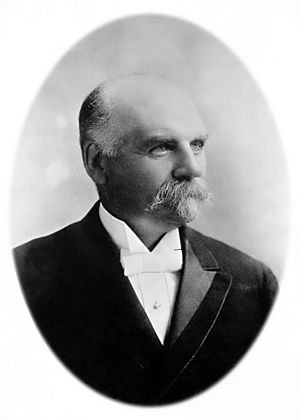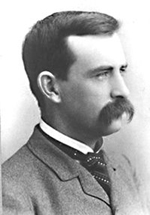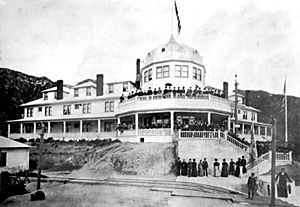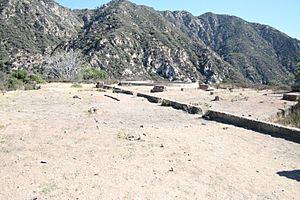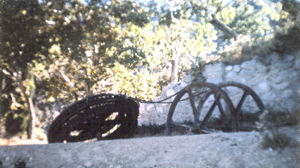Mount Lowe Railway facts for kids
The Mount Lowe Railway was an amazing mountain railroad built for tourists in California, north of Los Angeles. It was the third of its kind in America, located on Echo Mountain and Mount Lowe. This special railway operated from 1893 until 1938. What made it unique was that it was the only scenic mountain railroad in the United States that used electric power from overhead lines, like a trolley!
Professor Thaddeus S. C. Lowe and his engineer, David J. Macpherson, dreamed up this railway. They wanted to make the beautiful San Gabriel Mountains easy for everyone to visit. The railway opened on July 4, 1893, and had almost seven miles of track. It started in Altadena, California, at a place called Mountain Junction.
On top of Echo Mountain, there was a grand 70-room hotel called the Echo Mountain House, and a 40-room Echo Chalet. There was also an observatory for looking at stars, train repair buildings, places for workers to stay, a dance hall, and even a small zoo with local animals!
Professor Lowe faced many challenges while running the railway. Eventually, he had to sell it. Over the years, natural disasters like fires and floods destroyed the buildings and tracks. The Echo Mountain House burned down in 1900. More fires and floods followed, and by 1938, a big flood washed away most of what was left. The railway was officially closed after that.
Today, you can still see the ruins of the Mount Lowe Railway. They remind us of this incredible project. The railway was added to the National Register of Historic Places on January 6, 1993, recognizing its importance in history.
|
Mount Lowe Railway
|
|
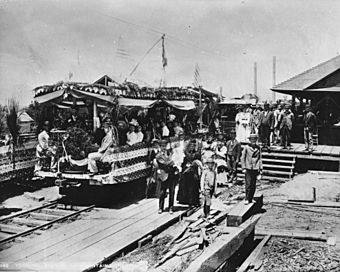
Opening Day ceremonies of the Mount Lowe Railway at Mountain Junction, the corner of Lake Avenue and Calaveras Street, Altadena, Ca., July 4, 1893
|
|
| Location | Mount Lowe |
|---|---|
| Built | 4 July 1893 |
| Architect | David J. Macpherson |
| NRHP reference No. | 92001522 (original) 14001146 (increase) |
Quick facts for kids Significant dates |
|
| Added to NRHP | January 6, 1993 |
| Boundary increase | January 14, 2015 |
| Mount Lowe | |
|---|---|
 |
|
| Overview | |
| Status | Defunct |
| Owner | Pacific Electric |
| Locale | Southern California |
| Termini | Pacific Electric Building Alpine Tavern |
| Stations | 31 |
| Service | |
| Type | Light rail, Funicular |
| System | |
| Operator(s) | |
| History | |
| Opened | 1902 |
| Closed | 1938 |
| Technical | |
| Track gauge | 4 ft 8 1⁄2 in (1,435 mm) (Mountain Division); 3 ft 6 in (1,067 mm) gauge (other divisions) |
Contents
Exploring the Mount Lowe Railway
The Mount Lowe Railway started at Mountain Junction in Altadena, California. This was at the corner of Lake Avenue and Calaveras Street. The railway had three main sections: the Mountain Division, the Great Incline, and the Alpine Division. The trains were powered by electricity. This electricity came from special power stations that used either gas engines or water wheels, depending on how much mountain water was available.
The Mountain Division: Starting the Journey
The Mountain Division was the first part of the railway. It began as a narrow-gauge line, meaning its tracks were closer together than standard tracks. A trolley car would go up Lake Avenue, then turn onto a private path through the Poppyfields area. It continued into Rubio Canyon, leading to the base of Echo Mountain.
Along this part of the line, there were stops at places like Newkirk, Poppyfields, Hygeia, and Roca. A bridge called Las Flores Bridge crossed the Rubio Wash. At Rubio, there was a large platform and a 12-room hotel called the Rubio Pavilion. Visitors could also explore the canyon using stairways and bridges to see eleven named waterfalls. In 1903, the Mountain Division's tracks were changed to a wider, standard gauge.
The Great Incline: Climbing Echo Mountain
From the Rubio Pavilion, passengers could switch to the "Great Incline." This was a special type of railway called an inclined plane railway or funicular. It used a cable to pull cars up and down the very steep slope of Echo Mountain, which is about 3,250 feet high.
The Incline was designed by Andrew Smith Hallidie, who also invented the San Francisco cable cars. It had incredibly steep sections, some as steep as 62%! It climbed 1,900 feet in elevation. The Great Incline was special because it used three rails instead of the usual four. At the halfway point, it had a four-railed section where the cars could pass each other.
A remarkable part of the Incline was the Macpherson Trestle. This bridge was named after engineer David J. Macpherson. It crossed a deep granite canyon, over 150 feet deep, on a very steep slope. The cable system for the Incline was a continuous loop that raised and lowered the cars. At the top of Echo Mountain, a powerhouse held the winding motor and a large grip wheel that pulled the cable. The cars also had a safety cable and emergency brakes for extra security.
Echo Mountain: The White City in the Sky
Professor Lowe dreamed of making the beautiful mountains overlooking Altadena and Pasadena accessible to everyone. He wanted to build a railway deep into the forest, all the way to the top of Mount Wilson. He funded the project himself, and the railway eventually reached the base of Mount Lowe. At its peak, it was a very popular honeymoon spot in America.
The top of Echo Mountain became like a small town. It had restaurants, shops, employee dorms, and a power station. There was also a trolley repair building, observation decks, hiking trails, tennis courts, stables, and a small zoo. All the buildings were painted white, earning the nickname "The White City in the Sky" when seen from below. Even the "opera box" incline cars were white, visible from far away as they moved up and down the hill.
Behind the main Echo Mountain ridge, there was an observatory with a 16-inch telescope. Professor Lowe wanted the Mount Lowe Railway to be a center for astronomy. A famous astronomer, Dr. Lewis Swift, even discovered 95 new nebulae from this observatory because there was so little light pollution.
Professor Lowe used his special method of making hydrogen gas to power heating and lighting on Echo Mountain. He had a gas plant in Pasadena and piped the gas eight miles up the mountain. Later, electricity replaced this technology.
A huge searchlight, bought from the 1893 World's Fair in Chicago, was installed on Echo Mountain in 1894. This light was so powerful it could project a beam 35 miles away! People could even have the light shone on their homes for their birthdays. However, by the 1930s, it was considered a nuisance and was turned off for good.
The Alpine Division: Reaching Mount Lowe
The third section, the Alpine Division, opened in 1896. It had 3.5 miles of narrow-gauge track with 127 curves and 18 bridges. Only one car could operate at a time due to limited electricity. This division crossed Las Flores Canyon, offering amazing views of the Los Angeles area below. It rounded a point called the "Cape of Good Hope" and went deep into Millard Canyon.
The railway then reappeared on the front of the mountain and eventually ended in Grand Canyon, at the base of Mount Lowe. This spot was called Crystal Springs, and here, Professor Lowe built a 12-room Swiss-style hotel called "Ye Alpine Tavern." It also had cottages and tent cabins for more guests. The Tavern offered amenities like a wading pool, tennis courts, mule rides, a gift shop, a restaurant, and even a silver fox farm. This was the end of the line, almost 7 miles from where the journey began.
Building the Dream: History of the Railway
The idea for the Mount Lowe Railway came from the people of Pasadena who wanted an easy way to reach the top of the San Gabriel Mountains. There was a trail to Mount Wilson, but it was a very difficult trip that often took more than a day. Many ideas for mechanical transport were suggested, but none had enough money.
David J. Macpherson, an engineer from Canada who moved to Pasadena in 1885, proposed a steam-powered train. He met millionaire Thaddeus S. C. Lowe in 1890, and together they could finally make a plan happen. They visited Colorado to see the mountain railway to Pike's Peak. Lowe was impressed by city trolley systems and decided that electric power would be best for their mountain railway. This made the Mount Lowe Railway the only electric scenic mountain railway ever built in the U.S.
Starting the Company
In 1891, Lowe and Macpherson started the Pasadena & Mount Wilson Railroad Co. They planned to build the railway to Mount Wilson. However, they couldn't get the necessary permissions for that route. So, Macpherson suggested an alternate route towards Oak Mountain, a high peak west of Mount Wilson. They hired electrical engineer Almarian Decker, who calculated all the possibilities for an electric line and the funicular needed to climb Echo Mountain.
Construction Begins
Building the Mountain Division
Construction began in Rubio Canyon in September 1892. A terminal station was built in Altadena, next to another railway station. A narrow-gauge line was laid up an 8% slope to a point near Las Flores Street. From there, it turned east through the Poppyfields area and headed into Rubio Canyon.
At the end of this section in Rubio Canyon, a large platform was built. This included the Rubio Pavilion, a 12-room hotel with dining. The pavilion also had power generators using gas engines and Pelton waterwheels. Water came from reservoirs in the canyon streams, though it wasn't always plentiful. To entertain visitors, Lowe built stairways and bridges over the streams and waterfalls. The eleven waterfalls were all named and are still historical landmarks today.
Building the Great Incline
Work on the Great Incline was challenging because the slopes were so steep. Materials had to be carried up by laborers. Funiculars usually need four rails, two for each car, but there wasn't enough space. Professor Lowe cleverly came up with a plan to use only four rails where the cars passed each other, and three rails on the upper and lower parts, sharing the center rail. This smart three-rail design saved space and materials.
A major engineering achievement was the Macpherson Trestle. This bridge crossed a 150-foot-deep granite canyon over 250 feet of track on a very steep 62% slope. It was named after the chief engineer, David Macpherson, as was common for railway constructions.
The Great Incline's cable system was designed by Andrew Smith Hallidie, known for the San Francisco cable cars. It climbed 2,200 feet using about 6,000 feet of cable spliced into a continuous loop. This loop raised and lowered the cars. At the top of Echo Mountain, an incline powerhouse housed the winding motor and a 9-foot-diameter grip wheel. This wheel had 72 clamping "fingers" that gripped the cable smoothly.
The cable was a 1 5/8-inch steel cable, looped around the grip wheel at the top and a tension wheel at the bottom. The incline's slope changed three times, from a steep 62% at the bottom to a gentler 48% at the top. The cars were designed to adjust comfortably to these changes. A safety cable also ran through an emergency braking system under each car, able to stop the cars within 15 feet if the main cable failed.
Developing Echo Mountain
The Echo Mountain site was ready for opening day on July 4, 1893, with the 40-room "Echo Chalet." By November 1894, the grand 80-room Victorian "Echo Mountain House" was finished. It was a luxury hotel meant to compete with famous hotels like the Hotel del Coronado in San Diego.
Lowe, who loved astronomy, also put a 16-inch telescope and observatory on Echo Mountain. He wanted the Mount Lowe Railway to be the astronomy hub of the San Gabriels. He even got famous astronomer Dr. Lewis Swift to work there. Swift discovered about 95 new nebulae from Echo Mountain because the sky was so clear.
Professor Lowe's success was partly due to his method of making large amounts of hydrogen gas. He had a gas plant in Pasadena and piped the gas eight miles to Echo Mountain, where it was stored in a large container. This gas was used for heating and lighting, but electricity soon took its place.
Echo Mountain also had a small zoo with local animals like lynxes, raccoons, snakes, squirrels, and even a black bear. Next to the zoo were dormitories and a shop for train maintenance.
Lowe bought a three-million-candlepower searchlight from the 1893 World's Fair in Chicago. It was installed on Echo in 1894. The light was so powerful that Lowe's publicist, George Wharton James, claimed he could read a newspaper by its beam from his hotel window on Catalina Island! The beam could project 35 miles. Residents could even have the light shone on their homes for their birthdays. However, by the 1930s, the light was considered a public nuisance and was turned off permanently.
The Alpine Division: The Final Stretch
A third division, the Alpine Division, started construction in 1894. This long section of narrow-gauge track crossed three canyons to reach the base of Mount Lowe. The line started next to the incline landing, allowing passengers to easily transfer to the next trolley. Three trains were available for this line, but only one could run at a time due to limited electrical power.
The line crossed the wide Las Flores Canyon, offering amazing views of the Los Angeles area below. At one point, a tall bridge called High Bridge was needed to cross a deep canyon. The track then went around a cliff called the "Cape of Good Hope." On the other side, there was a straight section of track, 225 feet long. From there, the rails went deep into Millard Canyon before making a complete turn at Horseshoe Curve and heading back towards the mountain face.
Once again overlooking the valley, the train made a wide turn around the Circular Bridge. This bridge, more like a trestle, allowed the trolley to make a 340-degree turn on a 4% slope, gaining 12 feet in elevation over 500 feet of track. The wooden structure looked like a roller coaster, offering a thrilling view almost 100 feet straight down.
From the switchback, the train returned into Millard Canyon. At the point where Millard and Grand Canyons met, workers faced a large granite rock. It took eight months of dynamiting and clearing to create just enough space for the narrow-gauge cars. This spot was named Granite Gate. The last part of the track went deep into Grand Canyon on a gentle slope, ending at the base of Mount Lowe. Here, at a place called Crystal Springs, Lowe built a 12-room, Swiss-style hotel called "Ye Alpine Tavern." It also had cottages and tent cabins. The Tavern offered many features, including a wading pool, tennis courts, mule rides, a gift shop, a restaurant, and a silver fox farm. This spot marked the end of the line, nearly 7 miles from its starting point.
Visitors and Experiences
The Mount Lowe Railway officially opened on July 4, 1893. People gathered at Mountain Junction, which was quite remote. At that time, the only public transport to Altadena was the Los Angeles Terminal Railway, which ran from San Pedro. These trains ran only twice a day and were often late, so most people came by horse and buggy. This lack of easy transportation contributed to the railway's difficulties.
Despite this, it's estimated that about 3 million people rode the railway during its 45 years of operation. Many came from all over the country and the world. It was like a "Disneyland" of its time! Professor Lowe loved Independence Day and Christmas, often marking special events on those days. The Tavern even published a daily newspaper called the Echo, which listed the names and home states of daily visitors. It also had information about the railway and daily events.
At the top of the incline, Charles Lawrence, the official photographer, would take pictures of arriving visitors from a special platform. For 25 cents, visitors could buy a souvenir photo of their arrival on the incline car. George Wharton James, Lowe's publicist, also had his own publication promoting the railway.
Special megaphones called "echophones" were installed on Mount Echo. Visitors could shout into them and hear many echoes from the canyons below. The "sweet spot" could produce at least nine echoes! This phenomenon has even been studied by Boy Scouts.
In Millard Canyon, there was a special stop at Dawn Station, above the old Dawn Mines, a gold mining operation. The real mines were deep in the canyon, so a fake mine entrance was dug just a hundred feet below the track. This tricked people into thinking they had visited the mine and were ready to return to the train quickly.
The mountain itself offered beautiful nature and hiking trails. There was also a mule ride called the "Mount Lowe Eight," which took guests on a large figure-eight loop around Mount Lowe and Mount Echo, starting and ending at the Alpine Tavern without repeating any terrain.
In 1922, Henry Ford visited the Mount Lowe Railway. He returned with a Hollywood film crew who made a silent documentary of the trip, with cameras mounted on the various cars, including the Great Incline. Over 600 feet of this historic film is available at the Library of Congress.
Challenges and Disasters
The Mount Lowe Railway had four hotels along its line, but the huge cost of construction and low visitor numbers pushed Professor Lowe to his financial limits. By 1898, the railway went into receivership, meaning it was controlled by someone else, Jared Sidney Torrance. Both Lowe and Torrance tried to get government permission to build to the top of Mount Lowe. The government realized the entire railway was on Federal land (part of the Angeles National Forest) and demanded a proper lease. After reviewing Lowe's situation, Congress gave the control to Torrance in 1899, leaving Lowe with only the observatory. At this time, the railway was reorganized and renamed the Mount Lowe Railway. It was later sold at auction to Valentine Peyton, who came to California to run it.
Disasters Strike the Railway
In 1900, the Echo Mountain House burned down. It wasn't properly insured and was never rebuilt. Later, the astronomer Dr. Swift went blind and had to leave the observatory. Another astronomer, Prof. Edgar Lucien Larkin, was hired. He stayed until his sudden death in 1925. Disappointed, Peyton sold the railway to Henry E. Huntington, and it became part of the Pacific Electric Railway (PE), famous for its Los Angeles Red Car system.
The PE made some improvements, including adding a "casino" on Echo Mountain. This building was a dance hall, not a gambling place. Most historians believe it was built only a few months before the fire of 1905. That fire started when strong winds blew the roof off the casino onto the power station, burning everything on Echo Mountain except the observatory and the astronomer's cabin. Only the Incline Powerhouse was rebuilt in 1906. Other improvements included replacing rock foundations under bridges with strong concrete supports.
In 1909, an unusual electrical storm and flash flood destroyed the Rubio Pavilion. One of the caretakers' children was buried in the mud, and the parents were badly injured, spending years recovering. Three other children, who knew how to operate the incline cars, escaped to the top of the incline.
In 1928, strong Santa Ana winds blew down the observatory. The curator, Charles Lawrence, barely escaped. Luckily, he had packed up the expensive telescope lenses beforehand. The telescope has since been reinstalled at Santa Clara University.
In 1925, a large brick addition was built onto "Ye Alpine Tavern," and it was renamed "Mount Lowe Tavern." In September 1936, the tavern burned to the ground due to an electrical fire. The Pacific Electric Railway was essentially out of business for the Mount Lowe line, but they kept train operators on staff so as not to abandon the railway completely. Although there was some thought of rebuilding, a lack of water, poor location for relocation, and the high costs of construction and insurance led the PE to give up on the Mount Lowe Railway.
In December 1937, the Railroad Booster's Club, a group of PE enthusiasts, requested a final paid trip on the line for photos and souvenirs. A few months later, in March 1938, a three-day heavy rainstorm destroyed what was left of the railway. Caretakers on Echo Mountain were stranded for 17 days. After this disaster, the railway was officially abandoned.
Dismantling the Railway
The Red Car line continued to run into Altadena until 1941. At the start of World War II, a company was hired to dismantle the Mount Lowe Railway. They stripped the railway of all usable materials. In 1959, the Forestry Service began dynamiting the remains of buildings, calling them "hazardous nuisances." In 1962, the Incline Powerhouse was dynamited, but the gear mechanism was saved and placed as a monument to the railway.
A Historical Landmark Today
In 1992, a committee from the Pacific Railroad Society began a project to uncover the ruins of Echo Mountain. This was done under the supervision of Mike McIntyre, an archaeologist with the Angeles National Forest. On January 6, 1993, the Mount Lowe Railway was listed on the National Register of Historic Places. The Forestry Service dedicated a piece of land for a monument that would include all the railway's artifacts.
On July 4, 1993, a 100-year celebration was held on Mount Echo, and another celebration took place on Macpherson Parkway. Today, the Scenic Mount Lowe Railway Historical Committee, led by Brian Marcroft and John Harrigan, takes care of the artifacts and works on restoration projects. This group of uniformed forestry volunteers works closely with the forestry headquarters in Arcadia, California.
In 2005, Stacey Camp began an archaeological dig on a part of Mount Echo where workers' barracks once stood. This dig is part of Camp's doctoral research and is funded by a grant from Stanford University, also coordinated with the Forestry Service.
Images for kids





